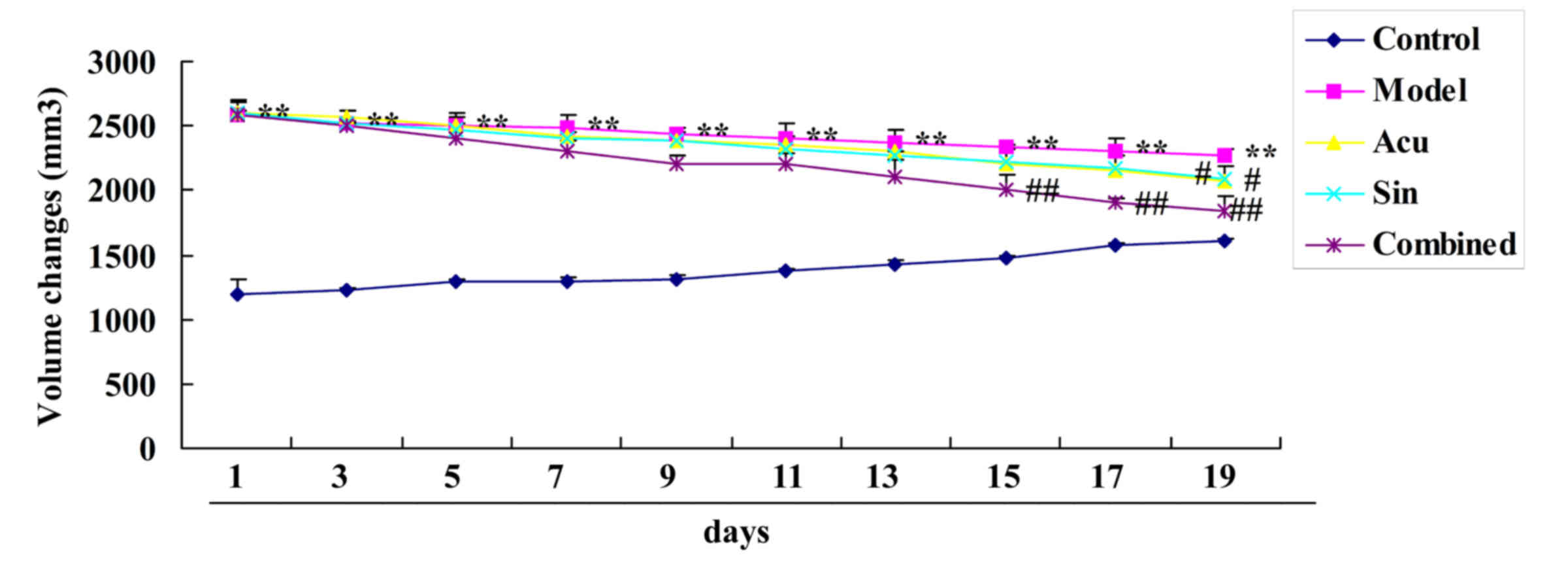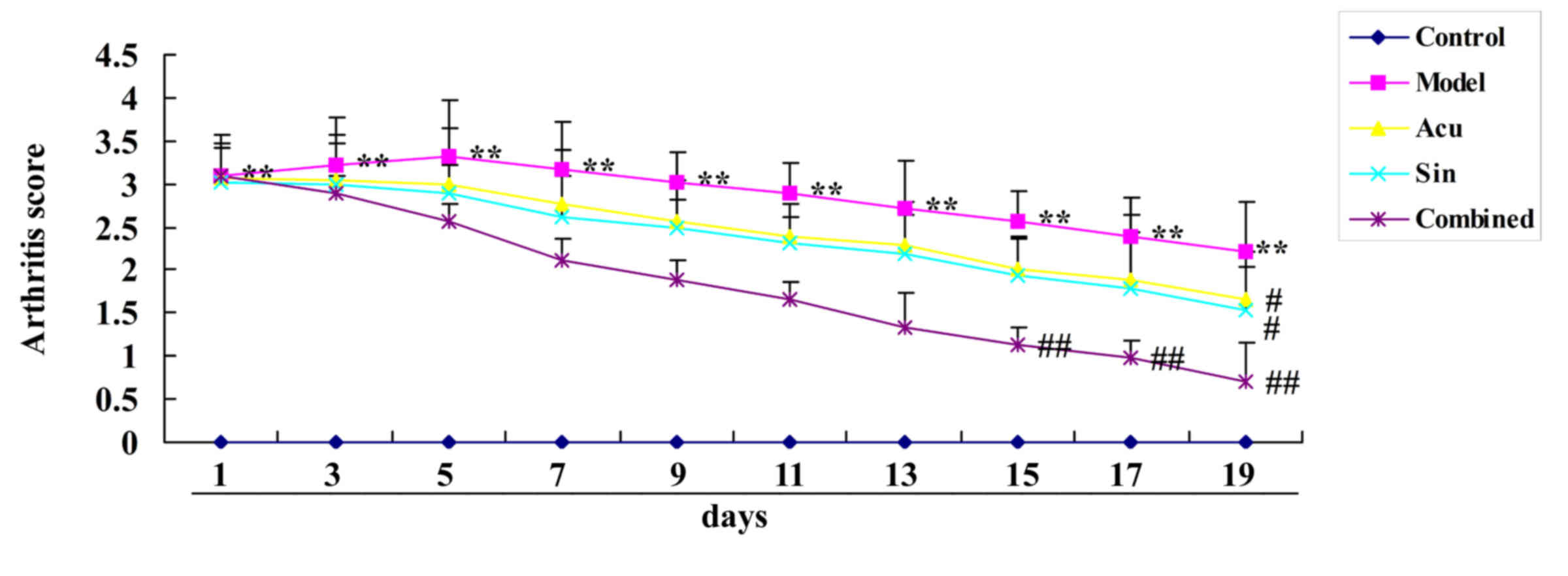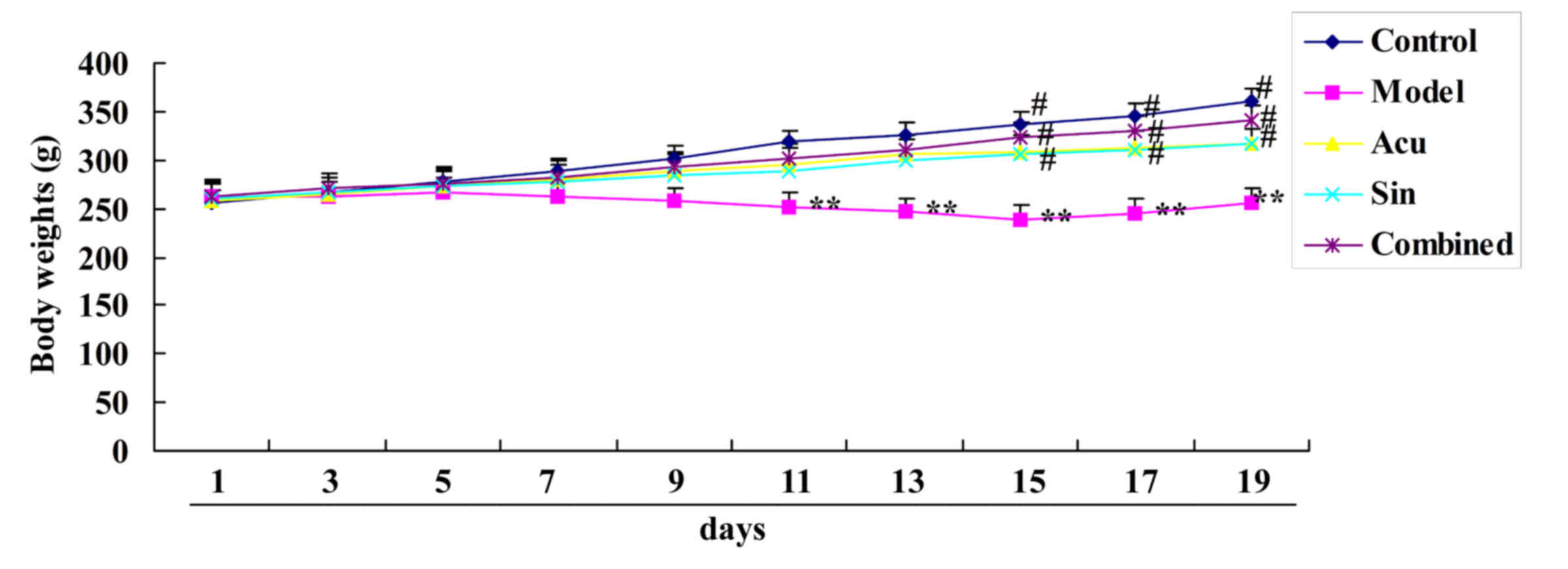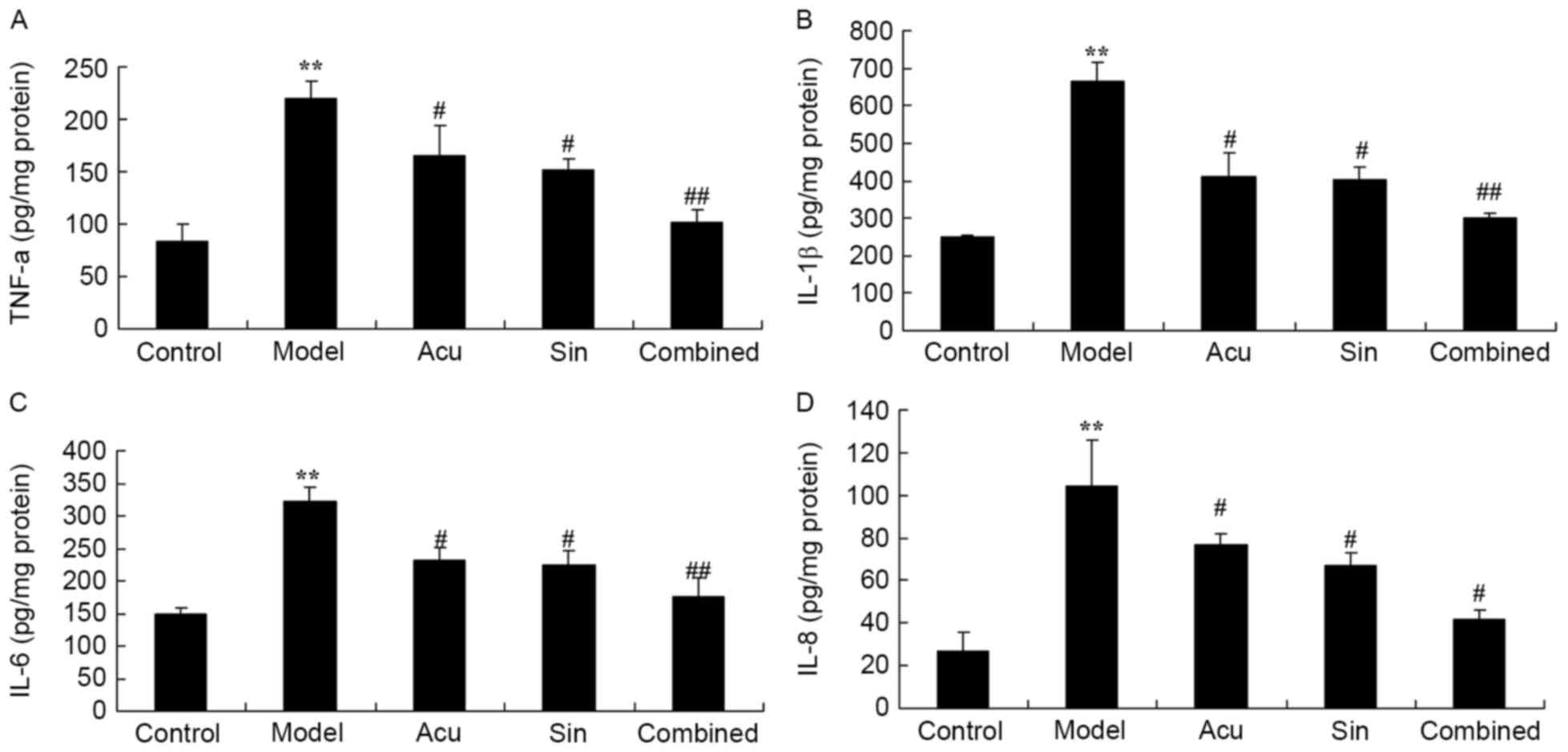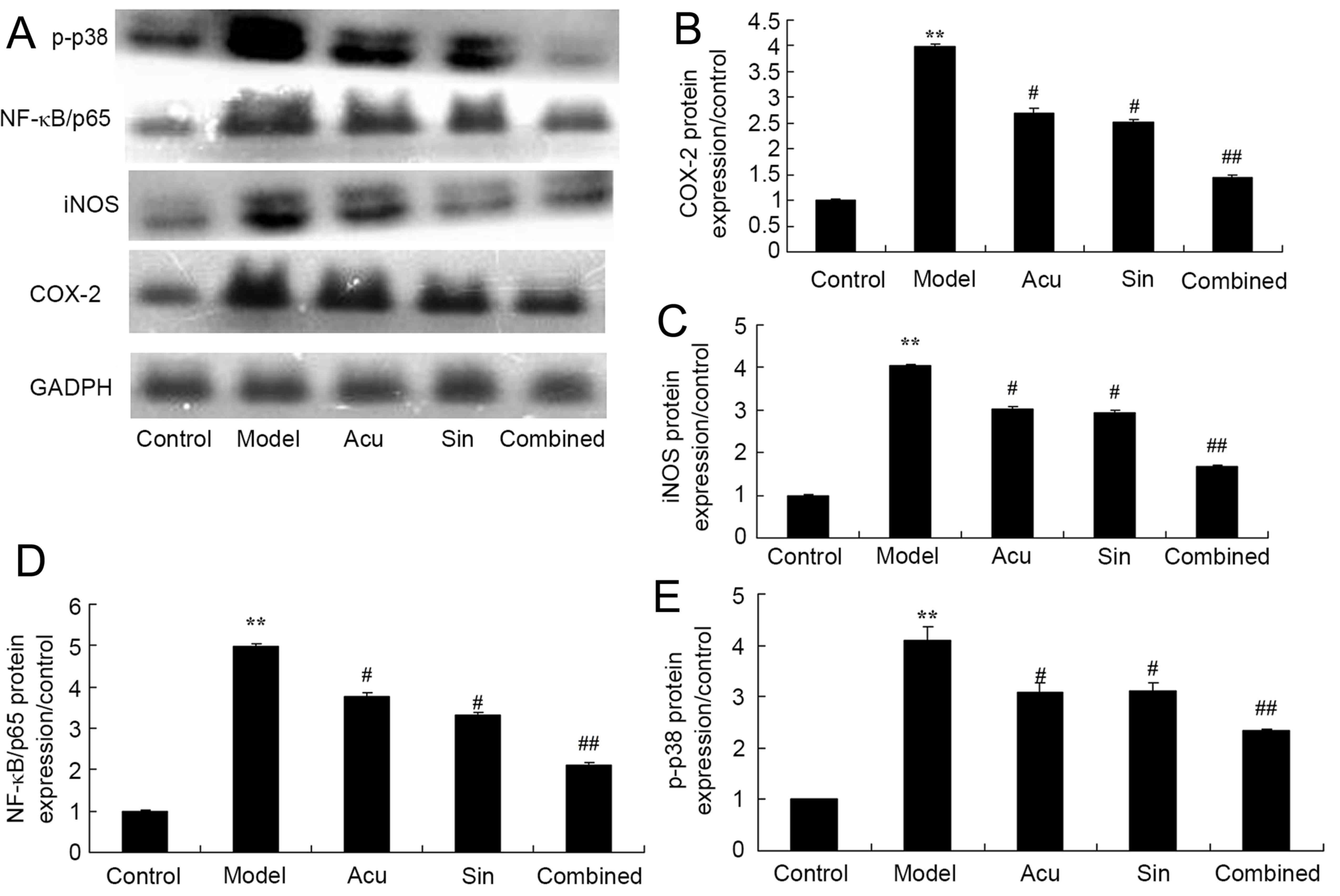Introduction
Rheumatoid arthritis (RA) is an autoimmune condition
characterized by chronic inflammation due to the host's own immune
system attacking joints across the body (1). Inflammation or damage of peripheral
tissues experienced in RA may lead to a series of alterations in
the spinal cord (2). As RA progresses
to an advanced stage, damaged articular tissue and arthromeningitis
are able to activate peripheral silent nociceptors (2). This causes continuous and intense silent
signals to be sent to the central nervous system for modulation and
integration, leading to the stimulation of excitatory amino acids
within the spinal cord, inducing the production and secretion of
cytokines (3). Furthermore, the
continuous excitability of spinal cord nociceptive neurons may be
enhanced (3).
Nuclear factor-κB (NF-κB), a nuclear transcription
factor in eukaryotes, is able to bind to nucleotide sequences in
promoter regions to activate genetic transcription, which may serve
a critical regulatory function in the genetic expression of a
number of genes, particularly inflammatory or
immunoreaction-related genes (4).
Activated NF-κB is able to combine with specific κB sequences in
gene promoter regions of inflammatory factors and participate in
genetic transcription of tumor necrosis factor α (TNF-α),
interleukin (IL)-1, IL-2, IL-6, IL-8, IL18, intercellular cell
adhesion molecule-1 (ICAM-1), COX-2 and nitric oxide synthase
(NOS). Within the nervous system, functional NF-κB exists in many
types of neural cell, including neurons, astrocytes, microglial
cells and oligodendrocytes, and participates in the regulation of
nerve cell apoptosis and, on a symptomatic level, aching following
nerve injury or an inflammatory response (5).
Mitogen-activated protein kinase (MAPK) is a key
molecular signaling pathway in eukaryotes and serves an essential
function in regulating cellular structure and functional activities
(6). In eukaryotes, the MAPK
signaling channel contains several subfamilies including p38,
extracellular-signal-regulated kinase (ERK), c-Jun N-terminal
kinase (JNK) and ERK5 (6). A previous
study demonstrated that the p38, ERK and JNK signal transduction
pathways had a marked association with cartilage injury identified
in RA (7). These signaling pathways
are able to induce cartilage cells to produce matrix
metalloproteinase (MMP), accelerate the pathological degradation of
cartilago articularis and also mediate a series of responses,
including the proliferation, apoptosis and differentiation of
chondrocytes (8). Clarification of
the underlying molecular mechanisms of the MAPK signaling pathway
in the occurrence and progression of RA is required in future
study.
Traditional Chinese medicine asserts that the
majority of middle-aged and elderly individuals with knee
osteoarthritis are caused by the deficiency of liver and kidney
function, insufficiency of vital energy, and blood, tendon and
vessel malnutrition (9). Sinomenine
is one monomer of Chinese traditional herbs and may possess
anti-inflammation, anti-oxidation and anti-apoptosis effects
(10). Acupuncture is an important
therapy used in complementary and alternative medicine, and may
exert anti-inflammatory effects (11). Acupuncture targets specific acupoints
to improve the body microenvironment and thus effectively treat
certain diseases (12,13).
Therefore, the present study investigated the
combined treatment of sinomenine and acupuncture on
collagen-induced arthritis.
Materials and methods
Animal experimentation
Protocols followed in the present study were
approved by the Animal Care and Use Committee [Chongqing TCM (No.
1) Hospital, Chongqing, China]. Male Sprague-Dawley rats (160±10 g)
were purchased from the Experimental Animal Center of Chongqing
Medical University (Chongqing, China) and maintained at 22±1°C and
55±5% humidity under a 12-h light/12-h dark cycle with free access
to a standard pellet diet and tap water.
Induction of collagen-induced
arthritis and grouping of data
All rats (n=50) were randomly assigned to 5 groups
(10 per group): Control, model, acupuncture treatment group,
sinomenine treatment group, and combined acupuncture and sinomenine
treatment group. Collagen-induced arthritic rats were
subcutaneously injected with 100 µl bovine type II collagen (Merck
KGaA, Darmstadt, Germany). Rats which developed arthritis following
collagen injection at 25 days were used in the present study.
Within the acupuncture treatment group, acupuncture was performed
on arthritic rats at the acupoints of Baihui and Yintang each day
for 19 days. Within the sinomenine treatment group, 50 mg/kg
sinomenine was gavaged into each arthritic rat every 2 days for 19
days. In the combined acupuncture and sinomenine group, acupuncture
treatment and 50 mg/kg sinomenine was gavaged into each arthritic
rat every 2 days for 19 days. In control and model groups, the
normal rats or collagen-induced arthritis rats were treated with
normal saline.
Evaluation of collagen-induced
arthritis
Paw length and overall body weight for each rat were
measured using vernier calipers every 2 days. Arthritis score was
calculated as follows: 0, unaffected; 1, 1 type of joint affected;
2, 2 types of joint affected; 3, 3 types of joint affected; and 4,
3 types of joint affected plus maximal erythema and swelling
(14).
Determination of serum cytokine
levels
Following the 19-day treatment regime, rats were
anesthetized with 40 mg/kg ketamine and 5 mg/kg xylazine, blood
samples were collected using an orbital blood sampling protocol
(14), and then rats were sacrificed.
Serum samples were prepared following centrifugation at 1,800 × g
for 15 min at 4°C. Serum levels of TNF-α (cat no. H052), IL-1β (cat
no. H002), IL-6 (cat no. H007), IL-8 (cat no. H008), superoxide
dismutase (cat no. A001-3), malondialdehyde (cat no. A003-1), MMP2
(cat no. H146-1) and MMP9 (cat no. H146-4) were determined using
commercial ELISA kits (Nanjing Jiancheng Bioengineering Institute,
Nanjing, China), according to the manufacturer's protocol.
Western blot analysis
Following homogenization of each synovial tissue
sample, total protein was extracted using radioimmunoprecipitation
assay buffer on ice for 30–60 min and determined using a
bicinchoninic acid assay kit. Total protein (50–100 µg) was
separated by SDS-PAGE (8–10% gel) and then transferred onto
polyvinylidene difluoride membranes (Bio-Rad Laboratories, Inc.,
Hercules, CA, USA). Membranes were blocked with 5% skimmed milk
powder in tris-buffered saline with 0.1% Tween 20 for 1 h at 37 °C
and incubated with primary antibodies against COX-2 (cat no.,
sc-7951, 1:500), inducible nitric oxide synthase (iNOS, cat no.,
sc-649, 1:500), NF-κB (cat no., sc-109, 1:500), phosphorylated p38
(cat no., sc-7975-R, 1:200) and GAPDH (cat no., sc-25778, 1:3,000)
overnight at 4°C. All primary antibodies were purchased from Santa
Cruz Biotechnology, Inc. (Dallas, TX, USA). Horseradish
peroxidase-conjugated goat anti-rabbit IgG secondary antibodY (cat
no., sc-2030, 1:5,000; Santa Cruz Biotechnology, Inc.) was
incubated with the membranes for 1 h at 37°C. Protein blanks were
visualized using an enhanced chemiluminescence detection reagent
(Bio-Rad Laboratories, Inc.), determined using a ChemiDoc XRS gel
imaging system (Bio-Rad Laboratories, Inc.), and analyzed using
Quantity One software (version 3.0; Bio-Rad Laboratories,
Inc.).
Statistical analysis
All data are presented as the mean ± standard
deviation and evaluated using one-way analysis of variance followed
by Dunnett's test. P<0.05 was considered to indicate a
statistically significant difference.
Results
Combined curative (CC) treatment
affects volume changes in collagen-induced arthritis
Results demonstrated that volume changes within the
collagen-induced arthritis model group were greater compared with
those of the control group (Fig. 1).
Treatment with acupuncture or sinomenine significantly inhibited
volume changes in collagen-induced arthritis model compared with
the control group (Fig. 1); however,
the CC treatment (acupuncture with sinomenine) significantly
inhibited volume changes in collagen-induced arthritis compared
with those of the acupuncture or sinomenine treatment groups
(Fig. 1).
CC treatment affects arthritis score
changes in collagen-induced arthritis
Results demonstrated that CC treatment affects the
arthritis score in collagen-induced arthritis. Fig. 2 demonstrates that the arthritis score
of the collagen-induced arthritis model group was increased
compared with that of the control group. Treatment with acupuncture
or sinomenine significantly decreased the arthritis score in
arthritic rats compared with that of the collagen-induced arthritis
model group (Fig. 2). Results
demonstrated that the CC treatment decreased the arthritis score in
collagen-induced arthritic rabbits compared with that of the
collagen-induced arthritis model group (Fig. 2).
CC treatment affects body weights in
collagen-induced arthritis
Results in Fig. 3
demonstrated that the overall body weight of collagen-induced
arthritic rats was decreased compared with that of the control
group. Treatment with acupuncture or sinomenine also led to a
significant increase in body weight in collagen-induced arthritic
rats compared with that in the collagen-induced arthritis model
group (Fig. 3). Furthermore, overall
body weights within the CC treatment group were increased compared
with those of the acupuncture or sinomenine treatment groups;
however, results were not statistically significant (Fig. 3).
CC treatment affects TNF-α, IL-6,
IL-1β and IL-8 serum levels in collagen-induced arthritis
Anti-inflammatory effects of CC treatment in
collagen-induced arthritis were determined. Fig. 4 presents the significant increase in
TNF-α, IL-6, IL-1β and IL-8 serum levels in collagen-induced
arthritic rabbits compared with those of the control group.
However, TNF-α, IL-6, IL-1β and IL-8 serum levels increases were
lessened by acupuncture or sinomenine treatment compared with the
model group (Fig. 4). The CC
treatment markedly reduced TNF-α, IL-6, IL-1β and IL-8 serum levels
in collagen-induced arthritic rabbits compared with those in the
acupuncture or sinomenine group (Fig.
4).
CC treatment affects SOD and MDA serum
levels in collagen-induced arthritis
Anti-inflammatory effects of the CC treatment on
oxidative stress in collagen-induced arthritic rabbits was
investigated. Compared with the control group, SOD serum level
inhibition and MDA serum level induction were observed in
collagen-induced arthritic rabbits (Fig.
5). Treatment with acupuncture or sinomenine significantly
increased SOD serum level inhibition and reduced MDA serum level
induction in collagen-induced arthritic rabbits compared with that
in the model group (Fig. 5). The CC
treatment significantly reversed SOD serum level inhibition and MDA
serum level induction in collagen-induced arthritic rabbits
compared with that in the acupuncture or sinomenine group (Fig. 5).
CC treatment affects COX-2, iNOS,
NF-κB and p-p38 protein expression in collagen-induced
arthritis
The CC treatment affected COX-2, iNOS, NF-κB and
p-p38 protein expression in collagen-induced arthritis. The results
demonstrated in Fig. 6 demonstrated
that COX-2, iNOS, NF-κB and p-p38 protein expression was
significantly increased in the collagen-induced arthritis model
group compared with that in the control group. Acupuncture or
sinomenine treatment significantly decreased COX-2, iNOS, NF-κB and
p-p38 protein expression in collagen-induced arthritic rabbits
compared with that in the collagen-induced arthritis model group
(Fig. 6). CC treatment significantly
decreased COX-2 protein expression in collagen-induced arthritic
rabbits compared with that in the acupuncture or sinomenine
treatment group (Fig. 6).
CC treatment affects MMP2 and MMP9
contents in collagen-induced arthritis
ELISA was utilized in order to unambiguously
investigate the effects of the CC treatment on MMP2 and MMP9 levels
in collagen-induced arthritis. Acupuncture or sinomenine treatment
significantly decreased MMP2 and MMP9 contents in collagen-induced
arthritis rats compared with those in the collagen-induced
arthritis model group (Fig. 7). CC
treatment significantly decreased MMP2 and MMP9 levels in
collagen-induced arthritic rats compared with those in the
acupuncture or the sinomenine treatment group (Fig. 7). Results in Fig. 7 demonstrate that MMP2 and MMP9 levels
in the collagen-induced arthritis model group were increased
compared with those in the control group.
Discussion
RA is characterized by fibrosis, rhagades, anabrosis
and the progressive destruction of the cartilago articularis,
formation of osteophytes within the joint margin and synovial
inflammation (15). RA is the primary
cause of joint disability in middle-aged and aged individuals. As
the aging population within China increases, the morbidity of RA
also increases annually (15,16). As a result, RA has attracted extensive
attention. Currently, RA therapy is insufficient in preventing
disease progression, eventually resulting in severe malformation in
the functioning of the joints (16).
In order to produce effective RA treatment, the underlying
molecular mechanisms require elucidation. Despite previous studies
outlining potential RA risk factors, including senility, obesity,
inflammation, trauma and genetic factors, the underlying molecular
pathogenesis of RA remains unclear (16). Results of the present study
demonstrated that CC treatment inhibited volume change decreases
and decreased the arthritis score in the paws of rats, and also
increased overall body weight in arthritic rats.
Evidence suggests that synovial inflammation serves
an important function in RA disease progression (17). Early-stage RA exhibits hypertrophic
synovium and fibrosis of the joints, secretion of inflammatory
cytokines and the presence of cartilage matrix-degrading enzymes
(17). In a previous study carried
out on patients with RA, arthroscopy was utilized following a
1-year follow-up visit and demonstrated that hypertrophic synovium
and changes in inflammation were increased by 50%, with an increase
in articular cartilage injury also evident (18). Therefore, synovial inflammation is
considered to be a predictive factor of the exacerbation of the
degeneration of articular cartilage in RA.
The stimulation of IL-1β was able to induce the
increase in MMP-2 expression in fibroblast-like synovial cells of
rheumatoid arthritis (19). Evidence
suggests that the synthesis and secretion of IL-15 in synovial
cells of RA is able to activate and stimulate T-lymphocytes and
therefore secrete pro-inflammatory cytokines in vitro. These
pro-inflammatory cytokines are able to stimulate synoviocytes to
express IL-15, IL-8 and IL-6 and induce a positive feedback
regulatory pathway (20). Activated
T-lymphocytes are also able to act on synoviocytes through the
secretion of IL-17, and stimulation of IL-8 and IL-6 expression
(21). The present study demosntrates
that CC treatment markedly inhibited TNF-α, IL-6, IL-1β and IL-8
serum levels, and COX-2 and iNOS protein expression in
collagen-induced arthritis rats compared with acupuncture or
sinomenine treatment alone.
NF-κB is a key molecule in the Toll-like receptor 4
(TLR4) signal transduction pathway (22). Several programmed cells that serve a
function in inflammation, immune response, cell apoptosis,
tumorigenesis and tumor metastasis are regulated by NF-κB (23). Therefore, developing therapies that
specifically target NF-κB in RA is of primary importance due to the
hypothesis that the destruction associated with RA may be decreased
through the suppression of NF-κB activity (23).
The TLR4 signaling pathway may also promote the
expression of synovioblasts in knee osteoarthritis (22). NF-κB has been associated with a
regulatory effect on osteopontin in arthritis (22). Results of the present study
demonstrate that CC treatment also inhibited NF-κB protein
expression in collagen-induced arthritic rats. Results of the
present study demonstrate that CC treatment also inhibited NF-κB
protein expression in collagen-induced arthritic rats. Zhao et
al (24) demonstrated that
sinomenine inhibits the maturation of monocyte-derived dendritic
cells through NF-κB expression. Furthermore, Zhang et al
(25) demonstrated that acupuncture
decreased NF-κB p65 expression in chronic atrophic rats with
gastritis.
Chondrocytes synthesize cartilage matrix and serve
an essential function in sustaining the normal structure and
function of the cartilago articularis. When chondrocytes are
stimulated by inflammatory (including TNF-α, IL-6, IL-1β and IL-8)
and mechanical stress, they transmit signals to transcription
factors through signal transduction pathways and regulate
pathophysiological processes including the production,
reconstruction, stability and repair of bone (26). The MAPK signaling pathway is the most
important signal transduction system in mediating cartilage injury
observed in RA (7). A recent study
suggested that a key pathological change in RA was the degenerative
degradation of the extracellular matrix (ECM), resulting in the
progressive loss of cartilage elements, and degeneration of the
structure and function of chondrocytes (27). In RA inflammatory and growth factors
combine with receptors on the cytomembrane to activate the MAPK
signal transduction pathway, leading to an increase in MMP
expression, apoptosis of chondrocytes and cartilage destruction
(28). Furthermore, MMPs are
essential in RA disease progression as these molecules degrade the
vast majority of cartilage ECM within the cartilago articularis
(29). In particular, MMP2, MMP3 and
MMP13 are the primary proteinases responsible for the acceleration
of ECM degradation in RA (30).
Therefore, repression of MMP2 and MMP9 expression may be a
potential therapeutic strategy for RA in the future (30). Results of the present study indicated
that CC treatment significantly suppressed p-p38 protein
expression, and MMP2/MMP9 levels in collagen-induced arthritic
rabbits when compared with acupuncture or sinomenine treatment
alone. Fu et al (30)
demonstrated that acupuncture promotes angiogenesis following
myocardial ischemia through p38-MAPK expression.
In conclusion, in the present study, CC treatment
inhibited volume changes and arthritis score changes within rat
paws, increased overall body weight, and suppressed inflammation,
oxidative stress, and COX-2, iNOS, MMP2 and MMP9 expression in
arthritic rats through the NF-κB and MAPK signaling pathways.
Further studies are required to validate the results generated from
the present study, and therefore provide an evidence base for the
future use of combined therapy (sinomenine and acupuncture) in the
treatment of RA.
Acknowledgements
Not applicable.
Funding
No funding was received.
Availability of data and materials
The datasets used and/or analyzed during the current
study are available from the corresponding author on reasonable
request.
Authors' contributions
MX and SL conceived and designed the experiments;
MX, RW and YC performed the experiments; MX and YC analyzed the
data; SL wrote the paper.
Ethics approval and consent to
participate
Protocols followed in the present study were
approved by the Animal Care and Use Committee of Chongqing TCM No.
1 Hospital (Chongqing, China).
Consent for publication
Not applicable.
Competing interests
The authors declare that they have no competing
interests.
References
|
1
|
Kuncewitch M, Yang WL, Jacob A, Khader A,
Giangola M, Nicastro J, Coppa GF and Wang P: Stimulation of
Wnt/β-catenin signaling pathway with Wnt agonist reduces organ
injury after hemorrhagic shock. J Trauma Acute Care Surg.
78:793–800. 2015. View Article : Google Scholar : PubMed/NCBI
|
|
2
|
Li B, Zhang H, Zeng M, He W, Li M, Huang
X, Deng DY and Wu J: Bone marrow mesenchymal stem cells protect
alveolar macrophages from lipopolysaccharide-induced apoptosis
partially by inhibiting the Wnt/β-catenin pathway. Cell Biol Int.
39:192–200. 2015. View Article : Google Scholar : PubMed/NCBI
|
|
3
|
Gottlieb J, Zamora MR, Hodges T, Musk AW,
Sommerwerk U, Dilling D, Arcasoy S, DeVincenzo J, Karsten V, Shah
S, et al: ALN-RSV01 for prevention of bronchiolitis obliterans
syndrome after respiratory syncytial virus infection in lung
transplant recipients. J Heart Lung Transplant. 35:213–221. 2016.
View Article : Google Scholar : PubMed/NCBI
|
|
4
|
Gerhardt SG, McDyer JF, Girgis RE, Conte
JV, Yang SC and Orens JB: Maintenance azithromycin therapy for
bronchiolitis obliterans syndrome: Results of a pilot study. Am J
Respir Crit Care Med. 168:121–125. 2003. View Article : Google Scholar : PubMed/NCBI
|
|
5
|
Teixeira MFC, Rodrigues JC, Leone C and
Adde FV: Acute bronchodilator responsiveness to tiotropium in
postinfectious bronchiolitis obliterans in children. Chest.
144:974–980. 2013. View Article : Google Scholar : PubMed/NCBI
|
|
6
|
Celik S, Doesch AO, Konstandin MH, Kristen
AV, Ammon K, Sack FU, Schnabel P, Katus HA and Dengler TJ:
Increased incidence of acute graft rejection on calcineurin
inhibitor-free immunosuppression after heart transplantation.
Transplant Proc. 43:1862–1867. 2011. View Article : Google Scholar : PubMed/NCBI
|
|
7
|
Cao XP, Han DM, Zhao L, Guo ZK, Xiao FJ,
Zhang YK, Zhang XY, Wang LS, Wang HX and Wang H: Hepatocyte growth
factor enhances the inflammation-alleviating effect of umbilical
cord-derived mesenchymal stromal cells in a bronchiolitis
obliterans model. Cytotherapy. 18:402–412. 2016. View Article : Google Scholar : PubMed/NCBI
|
|
8
|
Liu XY, Zhou XY, Hou JC, Zhu H, Wang Z,
Liu JX and Zheng YQ: Ginsenoside Rd promotes neurogenesis in rat
brain after transient focal cerebral ischemia via activation of
PI3K/Akt pathway. Acta Pharmacol Sin. 36:421–428. 2015. View Article : Google Scholar : PubMed/NCBI
|
|
9
|
Wu TT, Lu J, Zheng PQ, Liu SL, Wu J, Sun
W, Sun QM, Ma NX, Ding XL, Chen M and Zou X: Yiqi Huayu Jiedu
decoction inhibits the invasion and metastasis of gastric cancer
cells through TGF-β/Smad pathway. Evid Based Complement Alternat
Med. 2017:18712982017. View Article : Google Scholar : PubMed/NCBI
|
|
10
|
Fang M, Li J, Zhu D, Luo C, Li C, Zhu C,
Fan M, Yung KK and Mo Z: Effect of sinomenine on the
morphine-dependence and related neural mechanisms in mice.
Neurochem Res. 42:3587–3596. 2017. View Article : Google Scholar : PubMed/NCBI
|
|
11
|
Mi J, Chen X, Lin X, Guo J, Chen H, Wei L
and Hong H: Treatment of persistent allergic rhinitis via
acupuncture at the sphenopalatine acupoint: A randomized controlled
trial. Trials. 19:282018. View Article : Google Scholar : PubMed/NCBI
|
|
12
|
Wu MS, Chen KH, Chen IF, et al: The
Efficacy of Acupuncture in Post-Operative Pain Management: A
Systematic Review and Meta-Analysis. PLoS One. 11:e01503672016.
View Article : Google Scholar : PubMed/NCBI
|
|
13
|
Cui X, Zhou J, Qin Z and Liu Z:
Acupuncture for Erectile Dysfunction: A Systematic Review. Biomed
Res Int. 2016:21719232016. View Article : Google Scholar : PubMed/NCBI
|
|
14
|
Fan Q, Chen M, Fang X, Lau WB, Xue L, Zhao
L, Zhang H, Liang YH, Bai X, Niu HY, et al: Aging might augment
reactive oxygen species (ROS) formation and affect reactive
nitrogen species (RNS) level after myocardial ischemia/reperfusion
in both humans and rats. Age (Dordr). 35:1017–1026. 2013.
View Article : Google Scholar : PubMed/NCBI
|
|
15
|
Bergeron A, Chevret S, Chagnon K, Godet C,
Bergot E, de Latour Peffault R, Dominique S, de Revel T, Juvin K,
Maillard N, et al: Budesonide/Formoterol for bronchiolitis
obliterans after hematopoietic stem cell transplantation. Am J
Respir Crit Care Med. 191:1242–1249. 2015. View Article : Google Scholar : PubMed/NCBI
|
|
16
|
Kapila A, Baz MA, Valentine VG and Bhorade
SM: AIRSAC investigators: Reliability of diagnostic criteria for
bronchiolitis obliterans syndrome after lung transplantation: A
survey. J Heart Lung Transplant. 34:65–74. 2015. View Article : Google Scholar : PubMed/NCBI
|
|
17
|
Wang C, Xia T, Jiang K, Qiao X, Zhang X,
Li J, Wang J and Nie J: Apoptosis of the tracheal epithelium can
increase the number of recipient bone marrow-derived myofibroblasts
in allografts and exacerbate obliterative bronchiolitis after
tracheal transplantation in mice. Transplantation. 100:1880–1888.
2016. View Article : Google Scholar : PubMed/NCBI
|
|
18
|
Walker NM, Belloli EA, Stuckey L, Chan KM,
Lin J, Lynch W, Chang A, Mazzoni SM, Fingar DC and Lama VN:
Mechanistic target of rapamycin complex 1 (mTORC1) and mTORC2 as
key signaling intermediates in mesenchymal cell activation. J Biol
Chem. 291:6262–6271. 2016. View Article : Google Scholar : PubMed/NCBI
|
|
19
|
Ramirez AM, Shen Z, Ritzenthaler JD and
Roman J: Myofibroblast transdifferentiation in obliterative
bronchiolitis: Tgf-beta signaling through smad3-dependent and
-independent pathways. Am J Transplant. 6:2080–2088. 2006.
View Article : Google Scholar : PubMed/NCBI
|
|
20
|
Königshoff M, Kneidinger N and Eickelberg
O: Tgf-beta signaling in COPD: Deciphering genetic and cellular
susceptibilities for future therapeutic regimen. Swiss Med Wkly.
139:554–563. 2009.PubMed/NCBI
|
|
21
|
Zarin AA, Behmanesh M, Tavallaei M,
Shohrati M and Ghanei M: Overexpression of transforming growth
factor (TGF)-beta1 and TGF-beta3 genes in lung of toxic-inhaled
patients. Exp Lung Res. 36:284–291. 2010. View Article : Google Scholar : PubMed/NCBI
|
|
22
|
Ladak SS, Ward C and Ali S: The potential
role of microRNAs in lung allograft rejection. J Heart Lung
Transplant. 35:550–559. 2016. View Article : Google Scholar : PubMed/NCBI
|
|
23
|
Xu Z, Nayak D, Yang W, Baskaran G,
Ramachandran S, Sarma N, Aloush A, Trulock E, Hachem R, Patterson
GA and Mohanakumar T: Dysregulated microRNA expression and chronic
lung allograft rejection in recipients with antibodies to donor
HLA. Am J Transplant. 15:1933–1947. 2015. View Article : Google Scholar : PubMed/NCBI
|
|
24
|
Zhao Y, Li J, Yu K, Liu Y and Chen X:
Sinomenine inhibits maturation of monocyte-derived dendritic cells
through blocking activation of NF-kappa B. Int Immunopharmacol.
7:637–645. 2007. View Article : Google Scholar : PubMed/NCBI
|
|
25
|
Zhang J, Huang K, Zhong G, et al:
Acupuncture Decreases NF-kappaB p65, miR-155, and miR-21 and
Increases miR-146a Expression in Chronic Atrophic Gastritis Rats.
Evid Based Complement Alternat Med. 2016:94046292016. View Article : Google Scholar : PubMed/NCBI
|
|
26
|
Xu Z, Yang W, Steward N, Sweet SC,
Danziger-Isakov L, Heeger PS and Mohanakumar T: Role of circulating
microRNAs in the immunopathogenesis of rejection following after
pediatric lung transplantation. Transplantation. 101:2461–2468.
2017. View Article : Google Scholar : PubMed/NCBI
|
|
27
|
Dong M, Wang X, Zhao HL, Chen XL, Yuan JH,
Guo JY, Li KQ and Li G: Integrated analysis of transcription
factor, microRNA and lncRNA in an animal model of obliterative
bronchiolitis. Int J Clin Exp Pathol. 8:7050–7058. 2015.PubMed/NCBI
|
|
28
|
Mauad T, van Schadewijk A, Schrumpf J,
Hack CE, Fernezlian S, Garippo AL, Ejzenberg B, Hiemstra PS, Rabe
KF and Dolhnikoff M: São Paulo BO Study Group: Lymphocytic
inflammation in childhood bronchiolitis obliterans. Pediatr
Pulmonol. 38:233–239. 2004. View Article : Google Scholar : PubMed/NCBI
|
|
29
|
Moeser A, Pletz MW, Hagel S, Kroegel C and
Stallmach A: Lung disease and ulcerative colitis-mesalazine-induced
bronchiolitis obliterans with organizing pneumonia or pulmonary
manifestation of inflammatory bowel disease? Z Gastroenterol.
53:1091–1098. 2015. View Article : Google Scholar : PubMed/NCBI
|
|
30
|
Fu SP, He SY, Xu B, Hu CJ, Lu SF, Shen WX,
Huang Y, Hong H, Li Q, Wang N, et al: Acupuncture promotes
angiogenesis after myocardial ischemia through H3K9 acetylation
regulation at VEGF gene. PLoS One. 9:e946042014. View Article : Google Scholar : PubMed/NCBI
|















